Follow in the footsteps of the great Impressionists like Monet and Pissarro from Normandy to London.
As the boat approached the shores of Normandy, toward the French port of Dieppe, I felt awash in the light and atmosphere of the harbor. The saturation of the setting sun lit my way upon the trail of great masters of Impressionism like Monet and Pissarro. I began the journey in London days before, exploring the art movement’s beloved works and some of the subjects that inspired them.
Earlier that day, I boarded a ferry boat at the docks of Newhaven in the UK, just south of London, to sail the English Channel. A visit to remote Dieppe was key. It was the most beautiful spring day. Gliding along aboard the open-air DFDS Ferry (dfds.com/en), carried by inspiration, I could not imagine a more fitting route. The Danish-owned fleet offered all the conveniences today’s travelers desire along its many routes. I also found it comforting that DFDS is clear in its strides toward being environmentally sound for marine life sharing their habitat below.
The stretch of coast in the distance consisted of landscapes immortalized in the new wave of Impressionistic masterpieces that made a splash by the turn of the twentieth century. It is a faction of rogue artists rebelling against classical techniques, pushing back at how society saw things that we can thank for making waves. Perpetually in celebration, Normandy celebrates the history of Impressionism with verve. Its current 150th anniversary is seeing a wide array of festivities which can be explored online at Normandy Tourism (14, rue Charles Corbeau. Tel. +33 (0) 6 85 51 02 77. en.normandie-tourisme.fr).
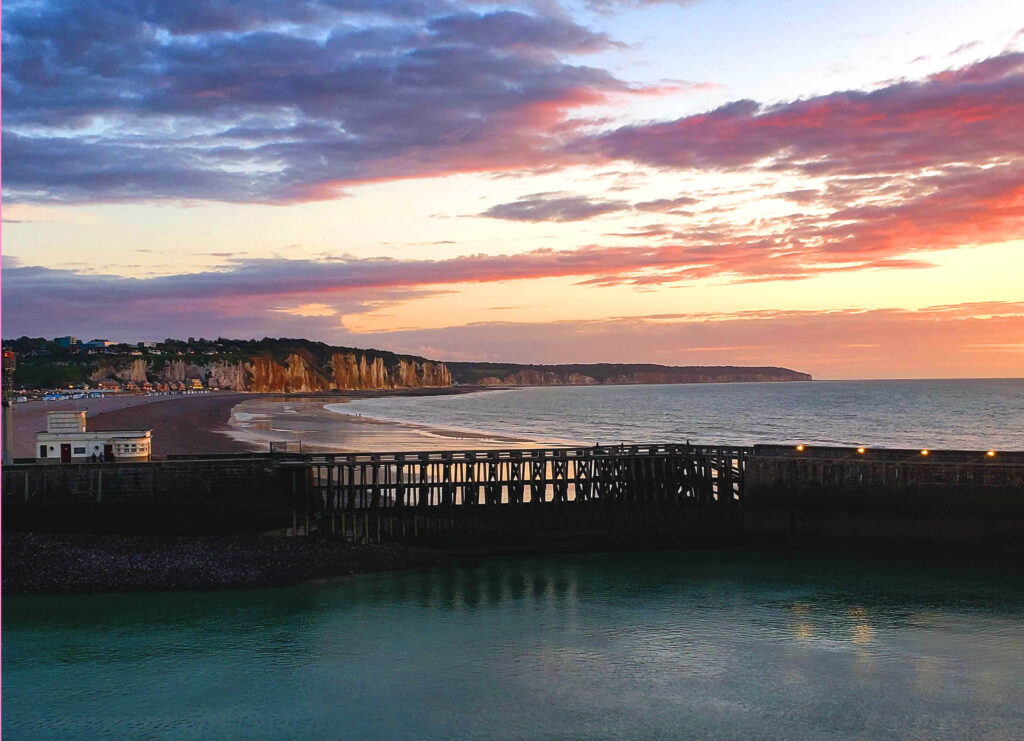
The Atmospheric Cliffs of Dieppe in the distance (Photo by C. Ludgate)
I tossed my bag atop my bed inside my sea-view stateroom, climbed to the upper deck, and nestled myself on a cozy wooden bench for a while. Some passengers had already begun to dine inside, some were at the bar or the lounge, while others, like me, were out there, gazing into the wild blue yonder under the Channel’s spell on a glorious four-hour sail. Eventually, my eyes began to see those transitory little brushstrokes synonymous with Impressionism capturing the energy of the scene.
The light and mist played upon Normandy’s famous Alabaster Cliffs as the boat approached the port. It was unmistakably Monet’s Cliffs de Dieppe (1882), unframed and alive. Awe-inspired by the vantage point, I gazed as we grew closer, taking in the fleeting moment. Ahh, Bienvenue.
DIEPPE, EN PLEIN AIR
As I walked in the evening along the coastal promenade of Dieppe, I imagined the world of artists, salon society, café life, and casino resorts that once thrived here in France’s first seaside resort town. The location was once host to the Victorian elite, serving as a summer getaway not too far from Paris. Iconic images of parasols and flared bustles along the water paint a picture of those days. While the upper crust may not remain there these days, the natural beauty and history indeed do.
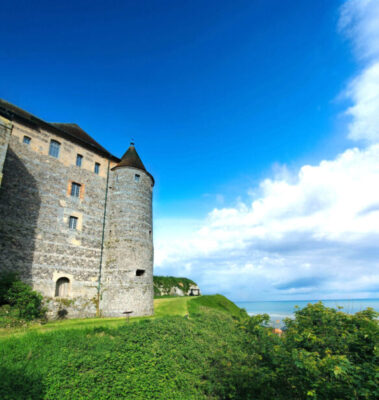
Chateau de Dieppe on the Cliffs (Photo by C. Ludgate)
The next morning, still beachfront in Dieppe, the mist gave way to sunshine above the sparkling blue Channel once again. The panoramic view from the Hôtel Mercure Dieppe la Présidence (1 Bd de Verdun, 76200. Tel. +33-2-3584-3131. mercure.accor.com) revealed a striking profile of Château de Dieppe (Rue de Chastes, Bd de la Mer, 76200. Tel. +33-2-3506-6199. uk.dieppetourisme.com) perched atop the adjacent cliff. The medieval castle, founded by King Henry II, served as a fortress many times over. Its walls now house a museum collection of local artifacts as eclectic as its history. Remnants of the citadel’s many incarnations exist to be explored just beyond the climb to an original postern door. In a little spot on a perch up there is a favored spot where Monet would position his easel, as evidenced by the scenes he had painted. It wasn’t hard to imagine the Father of Impressionism finding waves of inspiration, capturing the light and movement in those tiny brushstrokes on the canvas, en plein air.
Further from the steep edge of these towering cliffs, down through a cobblestone labyrinth with charming modest dwellings, my guide led me to the boat-filled marina. L’avant-port de Dieppe, Après-midi, Solei (1902) is one of Impressionism’s many notables. Beside the marina was signage marking the spot where a particular rendition of the scene was created by painter Camille Pissarro.
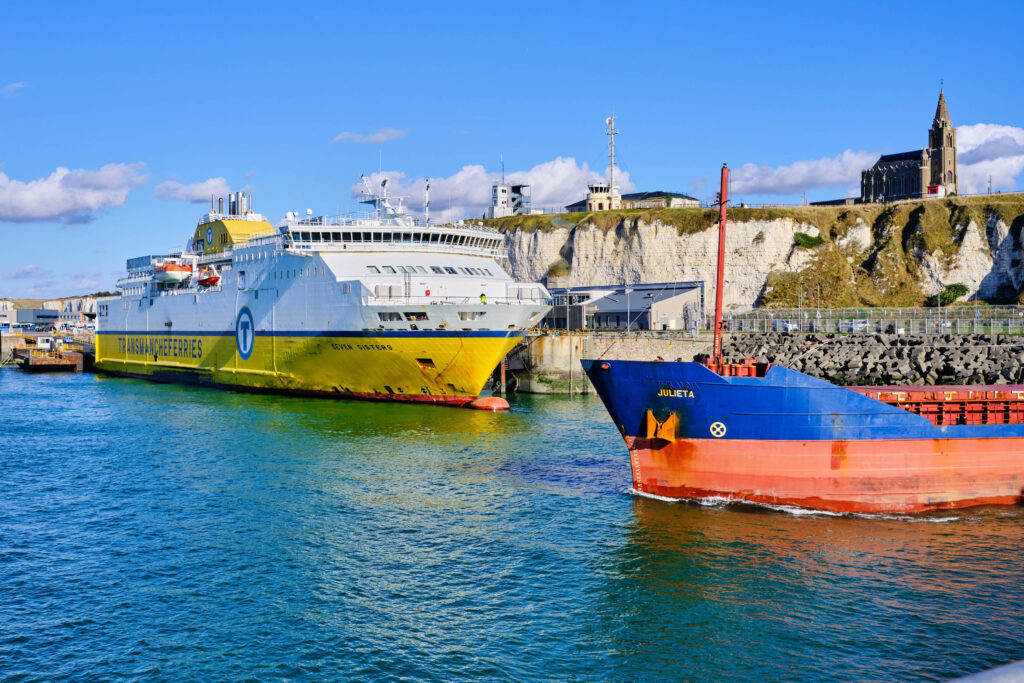
The Port in Dieppe, Normandy France (Photo by Nigel Wiggins)
Continuing on through Dieppe’s center, my guide pointed up to the little window of Pissarro’s in his former flat. Across from it was the Gothic Cathedral of St. Jaques, stretched out, beckoning to be his muse. And indeed it was. The town was gently waking with markets and cafes where great radical artists and writers once gathered with the likes of Oscar Wilde. It is said Wilde came directly to Dieppe after serving time in prison for admitting to being gay. The lights flickered in these time capsules that once served as muses. And for a transportive moment, it was as if time stood still.
GETTING PERSPECTIVE IN ROUEN
I bought a train ticket for the Nomad Normandie (nomad.normandie.fr) heading east of Dieppe en route to culturally rich Rouen. An hour passes so quickly on scenic trips like this. Known as the capital of Normandy, and dubbed the city of spires by Victor Hugo, Rouen is also pivotal in the history of Impressionism. Some say it’s the birthplace, but who’s to say. It is where the subject of Monet’s renowned Cathedral series (circa 1894) with its creamy light and lapis blue sky can be found. So many beautiful churches in Rouen with the sound of all those bells.
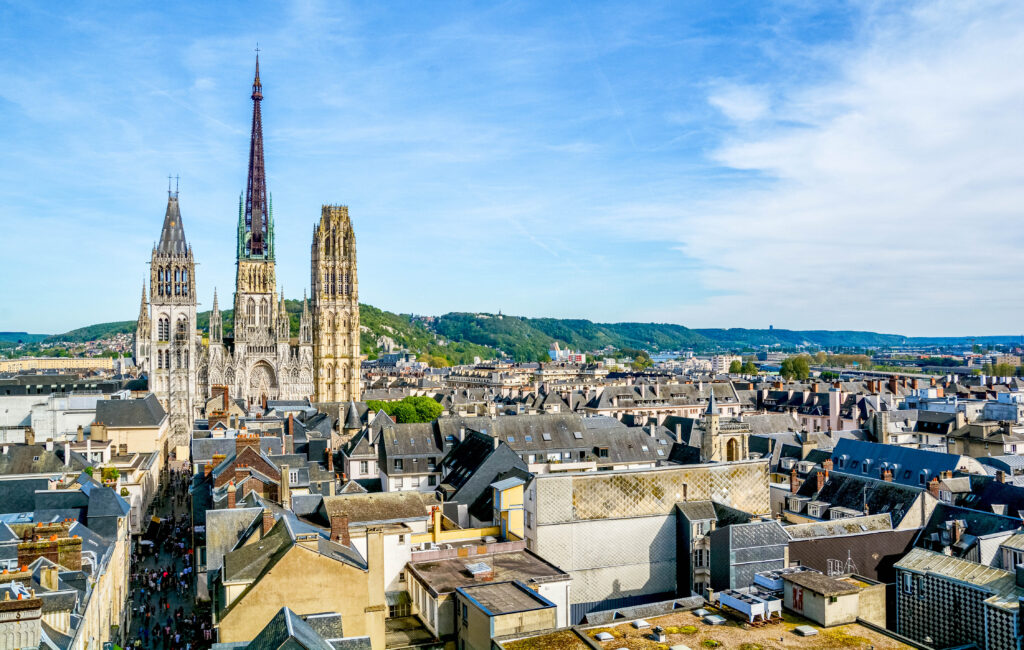
Rouen France (Photo by Essevu)
The weather was still dazzling, and I walked to the nearby trendy Radisson Blu (6-8 Rue du Donjon Tel. +33-2-7764-5757. radissonhotels.com) where my guide met me and my friend, Steve. We set out strolling on an illuminating tour of the very pedestrian-friendly city that included a visit to Musée des Beaux-Arts de Rouen (Esp. Marcel Duchamp. Tel. +33-2-3571-28-40. mbarouen.fr/en). When a guide has a sincere reverence for his subject, it is time well spent. Frederic, a gentleman who serves as a guide with Rouen Tourism (Esplanade Marcel Duchamp. Tel. +33-2-3208-3240. en.visiterouen.com), took the reins with a fascinating unraveling of insights into the techniques and inspirations of the masters.
“Do you know why he painted the Cathedral? Do you know why they all chose what they did? It isn’t the architecture or the thing. They didn’t care about that. It was about the atmosphere, the ambiance, and the light. It’s about capturing the atmosphere and where it leads your eye.” Frederic revealed this with passion and fervor, detailing the ideas behind the movement.
We stepped back and contemplated the spontaneous energy on the canvas from afar. While one does not need to dissect it to enjoy Impressionism, hearing Frederic articulate the inspirations behind it, left me more impressed. Pretty ethereal paintings, perhaps even seemingly innocent, but in context they can be subtly provocative in their off-center perspectives.
UNEXPECTED HER-STORIES
We strolled hidden alleyways peppered with old timber-framed houses, ogling at the wildly ornate Gros Horloge clock, sampling cheeses in city center, and falling in love at a patisserie. We pondered the light and shadows by the Cathedral. On summer nights, a light show is illuminated upon its facade which is an intricate patchwork of architecture. Further on, we found ourselves in the chamber where Joan of Arc was horrifically tortured. And we visited the site where a church was erected in her honor. It stands exactly atop the spot where she was burned at the stake for the sake of France’s survival. I hadn’t intended it, but it was exactly 607 years ago on that very day.
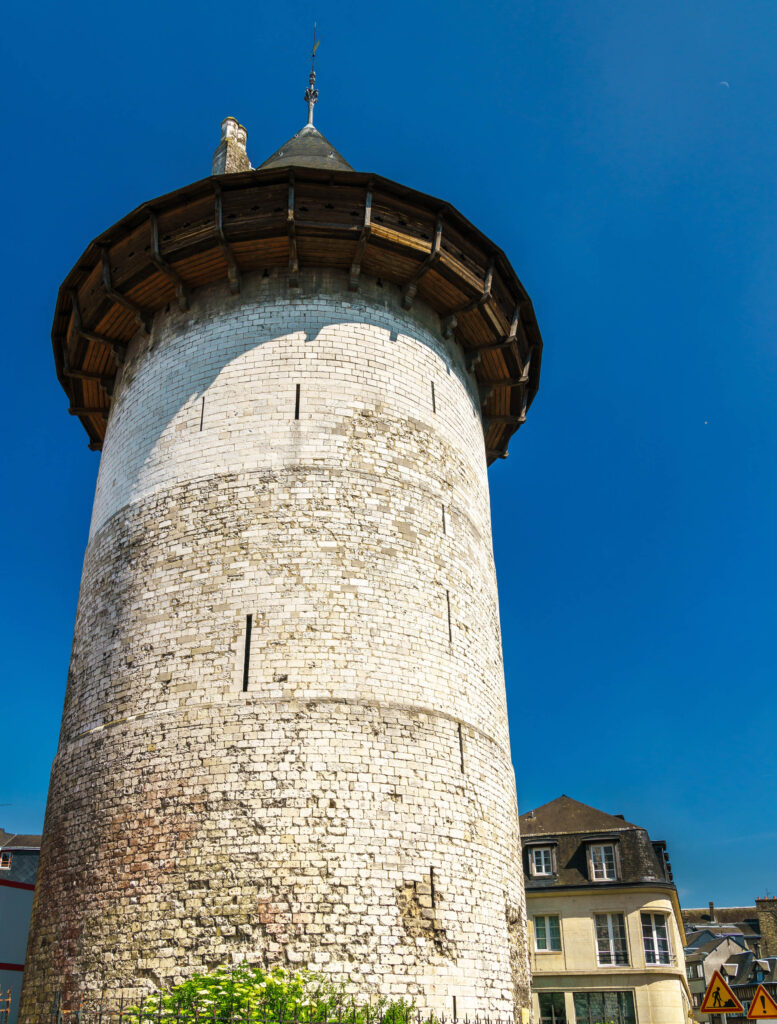
The remains of the castle Donjon de Rouen where Joan of Arc iwas imprisoned (Photo by Leonid Andronov)
The remains of the castle, Donjon de Rouen, where Joan of Arc was imprisoned before her demise stood directly at my hotel window. Stark and commanding, I gazed from my bed. I could almost touch it. I wanted to. It was evening, and after a revitalizing steam and reflexology treatment at Thalgo Spa in the hotel, we were headed out to explore. The city’s history resonated. I was amazed to find so many homages to St. Joan all around.
We arrived at La Couronne, the oldest inn in France, established in 1345. Yes, 1345. I was excited about a traditional Calvados experience there, as my friend Steve had never tried it. Calvados is native to Normandy and is a popular digestif similar to apple brandy. The server heated a crystal glass on the open flame dancing upon the rim of another and poured the potent potable. Classic screen star and German ex-pat, Marlene Dietrich, is quoted to have said that Calvados and chocolate got her through the war. Hearty gal. And good taste.
La Couronne also has the distinction of being the very first French restaurant Chef Julia Child ate at. And it was here, back in 1948, that she became inspired to learn to cook.
CHEZ MONET
The soft imagery and ambiance conjure watery moods and vague stories with magical splashes of color. Monet’s ethereal floral landscape pieces may look as if they could have been dreamed up. Fortuitously, new pigments were making their way onto the market at the time. Monet, who was also a gifted horticulturist, insisted on very particular inspirations for which to use them. And so, by design, his paintings were often inspired by the gardens of his Normandy houses. In Giverny, the elaborate gardens are still in their glory today and can be seen at Maison et Jardins de Claude Monet (84 Rue Claude Monet. Tel. +33-2-3251-2821. fondation-monet.com), where Monet lived with his family for 43 years.
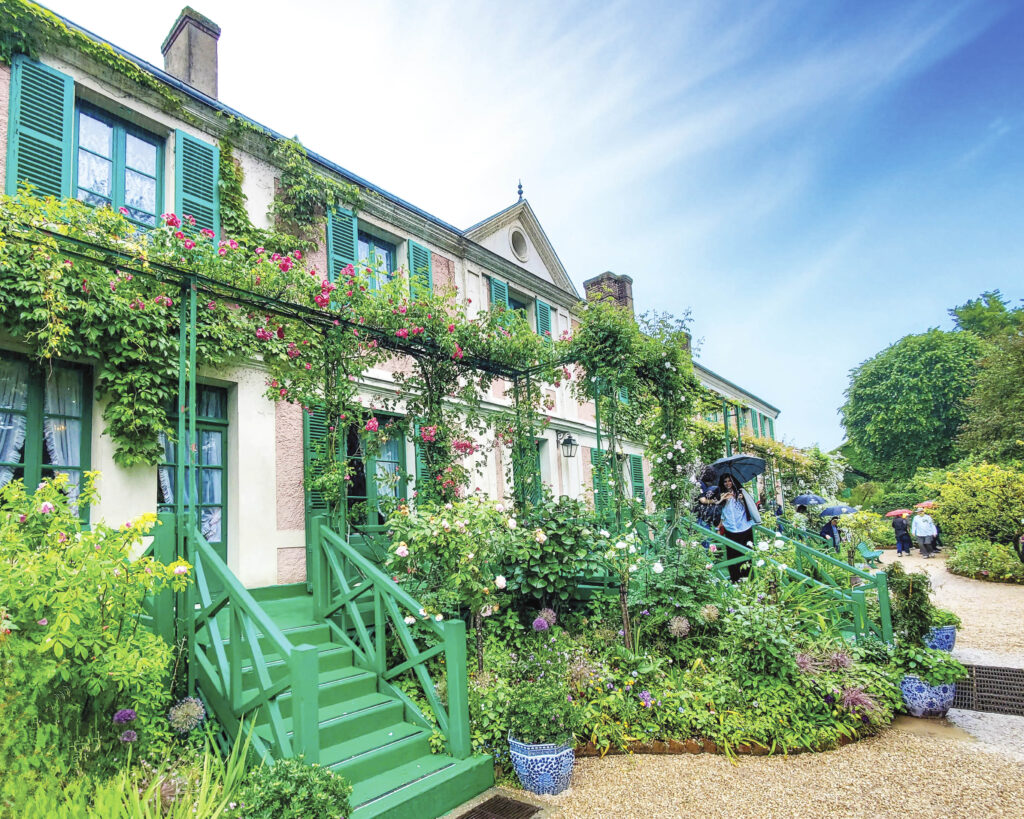
Monet’s House and Gardens in Giverny (Photo by C. Ludgate)
With pastoral scenes whooshing by my window, I was Giverny bound on the Nomad Normandie from Rouen and arrived in the blink of an eye. The light morning rain was clearing, but I opted to buy a ticket for the shuttle at the Giverny Station and stroll Chez Monet at my own pace. Bike tours are also offered through the Monet Foundation website. Going rogue on a bike rental right from the station is another option. I took note of the local taxi phone numbers listed by the shuttle drop-off should I decide to taxi back to the train.
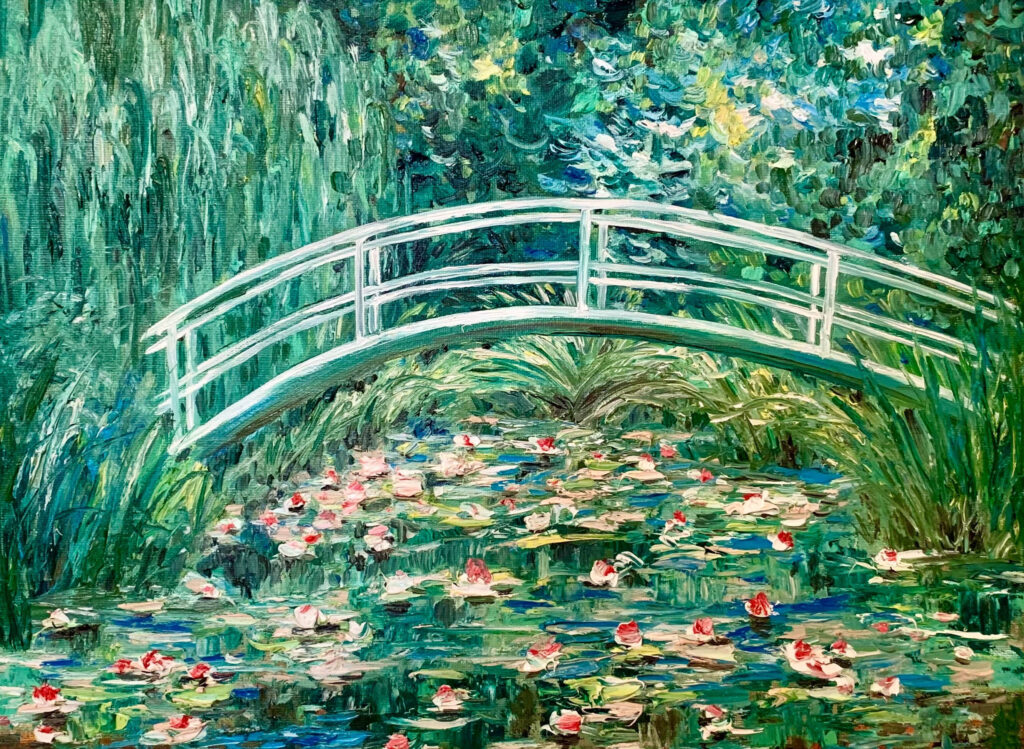
Artist Rendition of a Claude Monet Painting (Photo by Victoria OM)
It really was like walking through a daydream. Frames of reference to Monet’s inspirations appeared all around. The Japanese footbridge hid in the flora, reflecting vaguely in the water lily pond. The arched rose bushes with those beautiful pinks. The coy effusion of light through the clearing clouds created a reveal of vibrant colors.
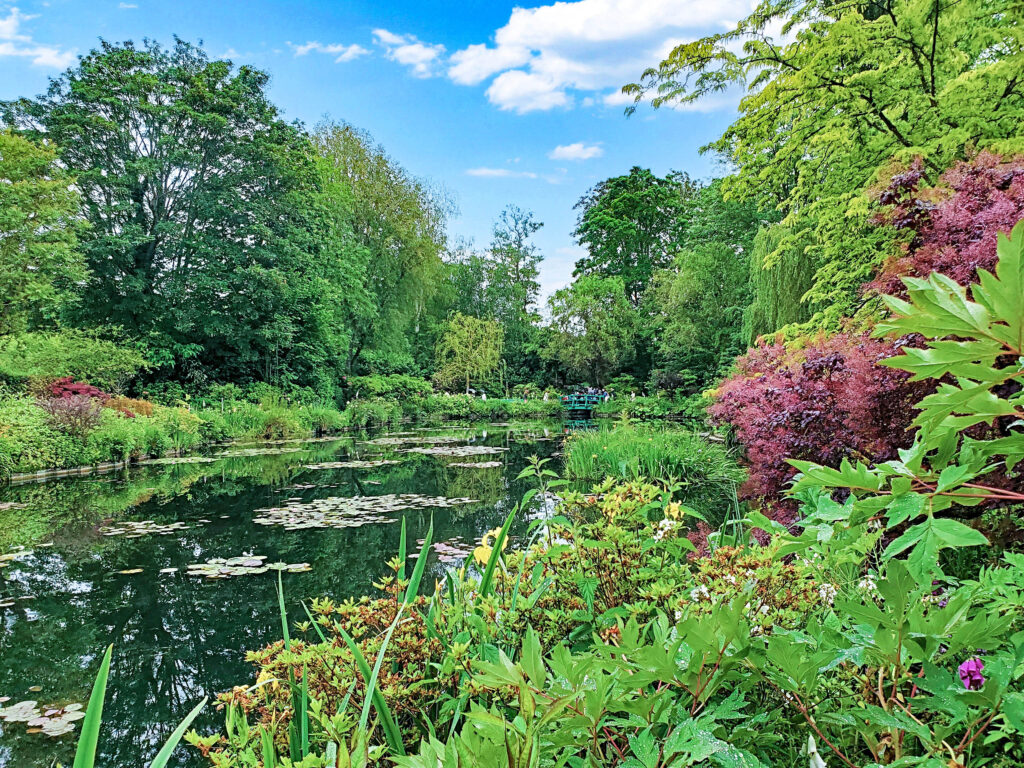
Water lily pond at Monet’s Garden in Giverny (Photo by C. Ludgate)
The mild microclimate is part of the region’s magic, providing Normandy with an ideal balance for its lush landscapes, I learned. Monet’s experience in gardening bestowed him with powerful insights into his own brand of color theory, observing how light interacted with colors. The interior of the pink house with green trim offered an intimate look, too, including Monet’s choices as interior designer. I picked up a beautiful throw pillow in the great little gift shop.
ORIGINS AND LEGACY
The Musée des Impressionnisme Giverny (mdig.fr) is located on the grounds of the gardens, just a few steps away from a lovely garden cafe where I enjoyed an afternoon nosh and tea. Tickets are available separately from the gardens. The museum was founded with the support of Musée d’Orsay in nearby Paris, which houses a significant collection of Impressionist masterpieces from Degas, Bonnard, Caillebotte, and Renoir to name a few. Inside, I explored the origins and legacy of the movement, which is the foundation of the museum’s effective mission. It was an immersive deep dive into the museum’s Impressionism and the Sea exhibit. Arranged in an intimate, serene setting under ambient lighting with thematic categories like Low Tide and Storms, it was seductive. With Jongkind, Signac, Courbet, Manet, Guillaumin, and Gauguin…it’s an all-day affair if time allows. I lingered at one of my favorites, Coucher de Solei, Daubigny (1876), appreciating the angles, vantage points, sheens and glows, as I squinted and stared at the painting, letting the magic of Impressionism work its charm.
RENDEZVOUS IN LONDON
The Paris to London Express on the Eurostar (raileurope.com) returned me to the other side of the Channel in the blink of an eye at nearly 200 mph. Before the Normandy journey, I had wandered the permanent collection at The National Gallery London (Trafalgar Square. Tel. +44-20-7747-2885. nationalgallery.org.uk), as it offers a very comprehensive Impressionism collection exhibited in grand spaces. A stroll in nearby St. James Park paired quite nicely with a leisurely afternoon exploring the gallery. Combined, the cost was zero. Afterward, vegan bites at Mildred’s, Covent Garden (79 St Martin’s Ln. Tel. +44-20-8066-8393. mildreds.co.uk) provided tasty nourishment.
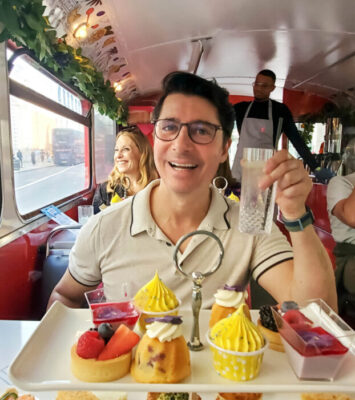
Steve on the Gin Afternoon Tea Bus Tour in London (Photo by C. Ludgate)
Upon returning to London, I ventured up the Strand and into The Courtauld at Somerset House (Somerset House, Strand. Tel. +44-20-3947-7777. courtauld.ac.uk), renowned for its Impressionism and Post-Impressionism collections. Completely immersed at this point, my experience felt more emotional here. I sat in the Great Room, overwhelmed by the beauty and the depth I was absorbing. I spent a little more time with Monet and Manet.
Afterwards, I joined Steve for some levity with an invitation to a Gin Afternoon Tea Bus Tour hosted by Brigit’s Bakery (6-7 Chandos Pl. Tel.+44-20-3026-1188. b-bakery.com), which took us for a spin around some of London’s greatest hits while sipping traditional English gin cocktails and noshing on traditional sumptuous tea treats that included warm scones with clotted cream. The experience was a class-act operation, a unique delight complete with a fun playlist, guide, and cute server happy to pop your cork.
Dusk was setting in as I left the fabulously stylish St. Ermins Hotel (2 Caxton St. Tel. +44-20-7222-7888. sterminshotel.co.uk), which oozes with intrigue as a once-secret spot with back room espionage. Churchill had a secret room there, too. It actually inspired a trip to the nearby Churchill War Rooms by St. James Park which is highly recommended.
I took a tip from the hotel concierge to hop on the easily accessible Thames Clipper by Uber near the Tower of London on my quest to see The Houses of Parliament and Victoria Embankment from the water. It felt like a peaceful and proper way to get a view of two of Monet’s biggest inspirations titled after their namesakes (circa 1900). The city’s lights were flickering on and the ambient glow sparkled in the water. Monet’s previous rendezvous with London in 1870 had less to do with inspiration than seeking refuge for his family during the Franco-Prussian War, but the burgeoning artist was said to be so enamored with the city that he vowed to return, and he did.
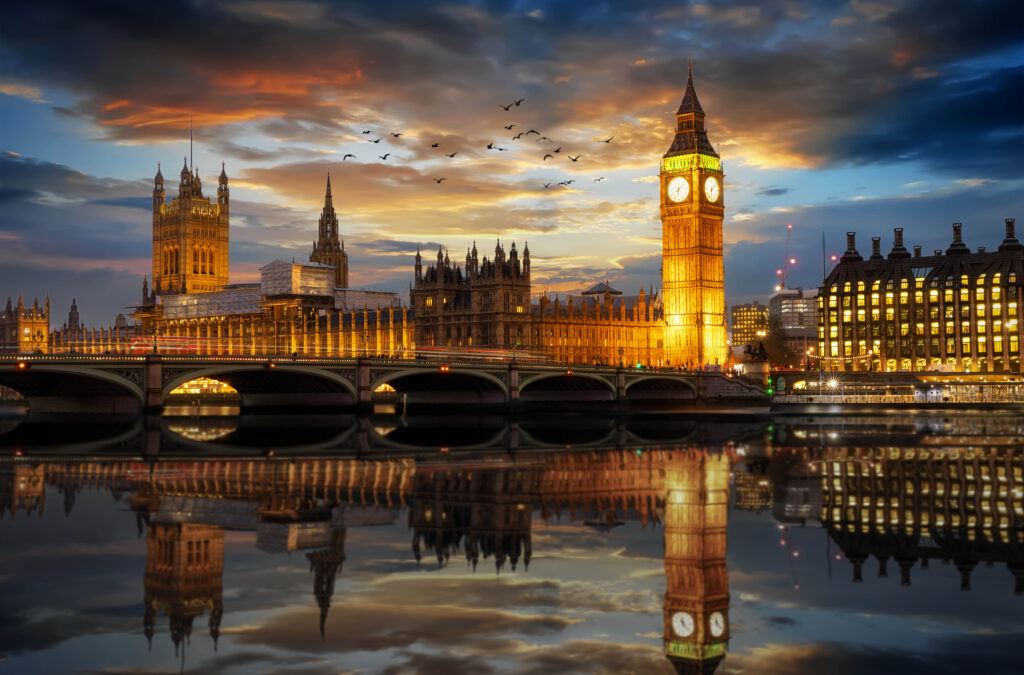
The Westminster Palace and The Big Ben Clocktower (Photo by Sven Hansche)
From the open air of the gliding Clipper, I could make out the silhouettes of spires against the darkening sky in the distance. It was unmistakable. The structure of the Houses of Parliament stretched there along the rippling water, becoming unclear beyond my field of vision, revealing just an impression. I glanced down, comparing the view, and there too, were the darker towering structures with points softened in the hazy, atmospheric pastel sky in the image of Monet’s Houses of Parliament, Sunset I saved to my phone. The suggestion of a boat appears off-center. I wondered as the sun disappeared, where Monet wanted my eyes to wander to, what the subject was? Perhaps it was just to be in, and appreciate, the moment.


